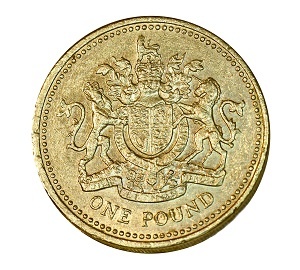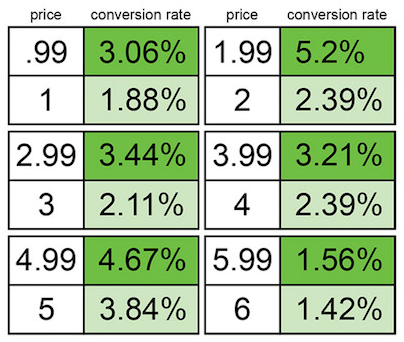We’ve already looked at the essential tenets of pricing your SaaS product. Now, we’re going to fine-tune our price, and optimise it for maximum sales conversions.
Before we get started, I want you to consider the following.

A pound coin has a fixed and objective value – it’s worth 100 pence.
Everybody who comes into possession of a pound coin has a good understanding of what it can buy, and should therefore place an equal value on the benefit of being given an extra pound.
To test this theory, let’s consider two radically different people:
Do these two people place the same value on that pound coin?
To somebody with savings of £1 million, a gain of £1 is almost negligible, an additional drop in the already sizeable ocean of their worth. To somebody with meagre savings of £1 however, a gain of £1 represents a 100% increase in their wealth. That single pound coin, near worthless to the millionaire, has the power to double their savings account.
This is a hugely simplified example, but the basic logic behind it is applicable to every purchasing decision we make. Our perception of prices can be influenced by myriad factors, the most important of which is context.
That’s the basic principle the following pricing hacks rely on: altering the context of our pricing to frame the purchase of your SaaS solution in the most effective and desirable way possible.
1) Anchored Pricing
Imagine you’re looking to buy a shirt. You’re cost-conscious, and unwilling to spend more than £50.
You enter an attractive high-street store, and find yourself steered towards an expensive display of three-piece suits, each priced at £2000 or above. You humour the salesman, well aware that you have no intention of spending that much on a suit.
A few minutes later, you’re standing in front of a display of shirts, priced at £100 each. With the suit’s £2000 price tag in your mind, paying £100 for a shirt seems like relatively good value. Before you know it, you’re in front of the till, paying for your new shirt with a smile on your face.
As you’re leaving, you realise you’ve just paid double what you originally intended to – and incredibly, you’re happy about it.
This is the power of price anchoring. The salesman didn’t expect you to buy the suits – he simply wanted their £2000 price tag to alter your price perception.
Before entering the store, you had a price of £50 in mind, and an increase of £50 was a huge price increase. After seeing the suit however, your subconscious price reference is a massive £2000 – and that £50 increase seems much smaller in comparison.
There are two simple ways to incorporate price anchoring into your SaaS pricing:
Pricing Page Positioning
On your pricing page, start by highlighting your most expensive solution.
Opening with your lowest price only serves to make your other price points seem relatively expensive. By opening with a big number, all of your proceeding prices will seem small by comparison - and likely contribute to an increased average spend.
Up-Selling and Cross-Selling
When up-selling and cross-selling existing clients, tailor your pitch to the price they currently pay for the service.
Their current bill is their reference point, and the higher the reference point, the more they’ll be happy to pay for an add-on - so pitch more expensive add-ons to users on higher price plans.
2) Left Digit Anchoring
The next day, you're at work. A few hours (and a dozen mugs of coffee) later, lunchtime rolls around, and you head out to your local baguette shop. As you queue to pay, you see the reflection of your new shirt in the polished counter, and you begin to ponder the power of pricing strategies.
Out of curiosity, you scan row after row of sandwiches, analysing their price tags. As you do, you identify a strikingly obvious pattern: every single item ends in the number 9.
The use of prices ending in 9 or 99 is known as charm pricing. It's a hugely popular pricing strategy, employed by businesses from all sectors, and despite its prevelance, still a hugely powerful tool for encouraging sales.
Our brains process numbers extremely quickly, performing simple value calculations without making us consciously aware of it. In this instance, our brain latches onto the first number of the price tag – the left digit – and uses this to form a reference point.
Though a £399 item is only £1 cheaper than a £400 item, the left digit effect means that the former is anchored to a reference of £300, and the latter of £400. A £1 price difference creates two subconscious price references that are £100 apart.
Obviously, this is a subconscious effect, and we’re able to consciously determine that both prices are only 1p apart. Crucially though, this doesn’t override the left digit effect.
Online marketplace Gumroad experimented with left digit anchoring, and compared the conversion rates of rounded price points, and those ending in .99. In every instance, charm prices outsold rounded prices.

Their findings aren’t unusual. In Priceless: The Myth of Fair Value, William Poundstone aggregates the findings of 8 separate studies into this phenomenon. The result?
Prices ending in 9 sold, on average, 24% better than the nearest rounded price point.
Even more incredibly, this phenomenon can’t always be attributed to cheaper prices. In a famous MIT study, identical items of clothing were sold at 3 different price points, of $34, $39 and $44.
Logic suggests that the cheapest price point would sell the most, but thanks to the left-digit effect, the $39 garments outsold both $34 and $44 price points.
In many instances, a 1p reduction in the price of your SaaS solution can be enough to lower your potential buyer's reference point by £10, £100, or even £1000. If the above example is anything to go by, it may even be possible to increase your price, and realise improved sales.
To test how this strategy impacts your sales, you can run a simple A/B split-test, and monitor the conversion rates of rounded price points and charm prices.
3) ‘Useless’ Price Points
You’re back at your desk, baguette in hand. You're looking for some lunch-time reading, and stumble onto the Economist’s pricing page. You're greeted by a seemingly bizarre selection of price points:
- Online subscription, £59
- Print subscription, £125
- Online and print subscription, £125
At half the price of the print version, the online subscription seems like good value – but it’s the last option that really piques your interest.
Instead of paying £125 for the print subscription alone, you can choose option 3, and bag yourself a free online subscription in the process. Happy with your decision, you click Purchase.
As you may have guessed, option 2 wasn’t designed to sell subscriptions – it exists only to make option 3 seem more attractive.
Without option 2, online subscriptions are valued at £59, and the value of a print subscription is implied to be £66.

When we introduce option 2, that valuation changes. The online subscription is still £59, but now, the print subscription is worth £125. Suddenly, the implied value of option three shoots up to £184.

With the introduction of a seemingly nonsensical price point, the most expensive subscription package suddenly becomes the most desirable – offering an implied saving of £59 over its true value.
If you operate a tiered pricing system, or offer a range of add-ons, a similar approach can be used to frame your own prices. Work out which tier or solution you’d most like to sell, and shape your price points to promote it.
- Basic Business Package (50 Users), £100 PCM
- 50 Additional Users, £150 PCM
- Pro Business Package (100 Users), £150 PCM
- Accounting Software, £100 PCM
- Invoicing Software, £150 PCM
- Accounting and Invoicing Package, £150 PCM
Pricing Your SaaS Product
These 3 hacks are designed to improve the fluidity of purchasing decisions.
They don't attempt to mislead buyers, or trick them into making purchases they won't benefit from.
Instead, they use a few core principles of behavioural economics to frame your SaaS solution in the most positive light possible - and help consumers make a quick, effective and beneficial decision.
Crucially though, these techniques aren't a panacea. Effectively selling your SaaS solution relies on a fantastic product, a steady influx of targeted traffic, and a smart and systematic approach to pricing your SaaS solution.
Once you've nailed the basics though, these 3 hacks can be a powerful tool for increasing your sales, and growing your business.
Looking for more SaaS pricing tips? Sign up to our free email course below.




